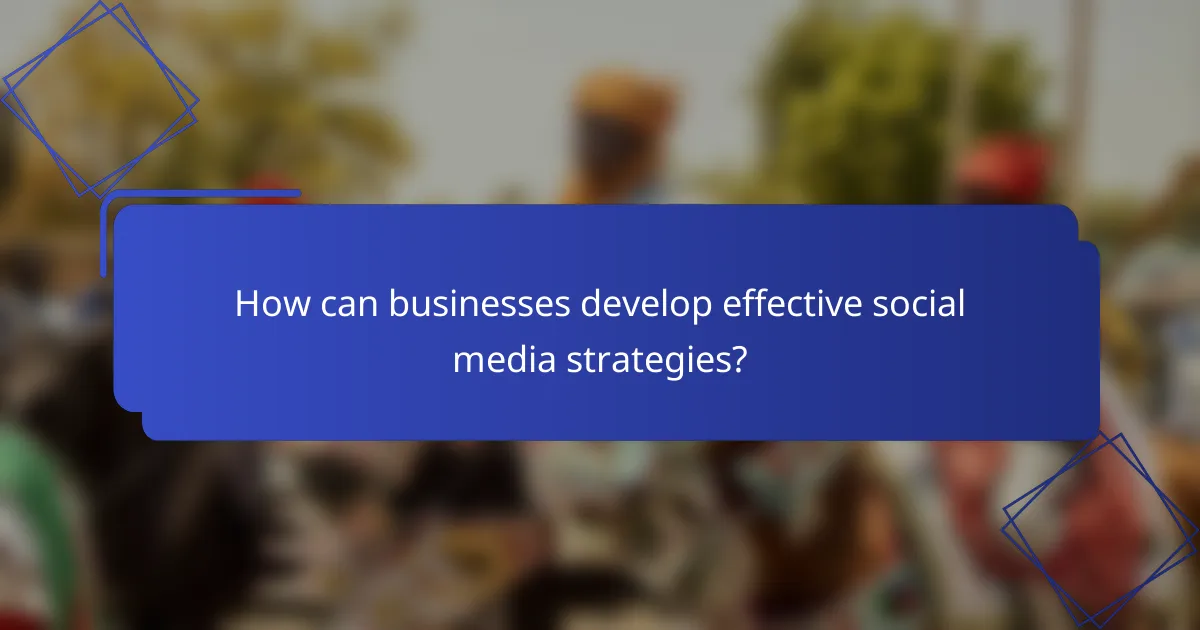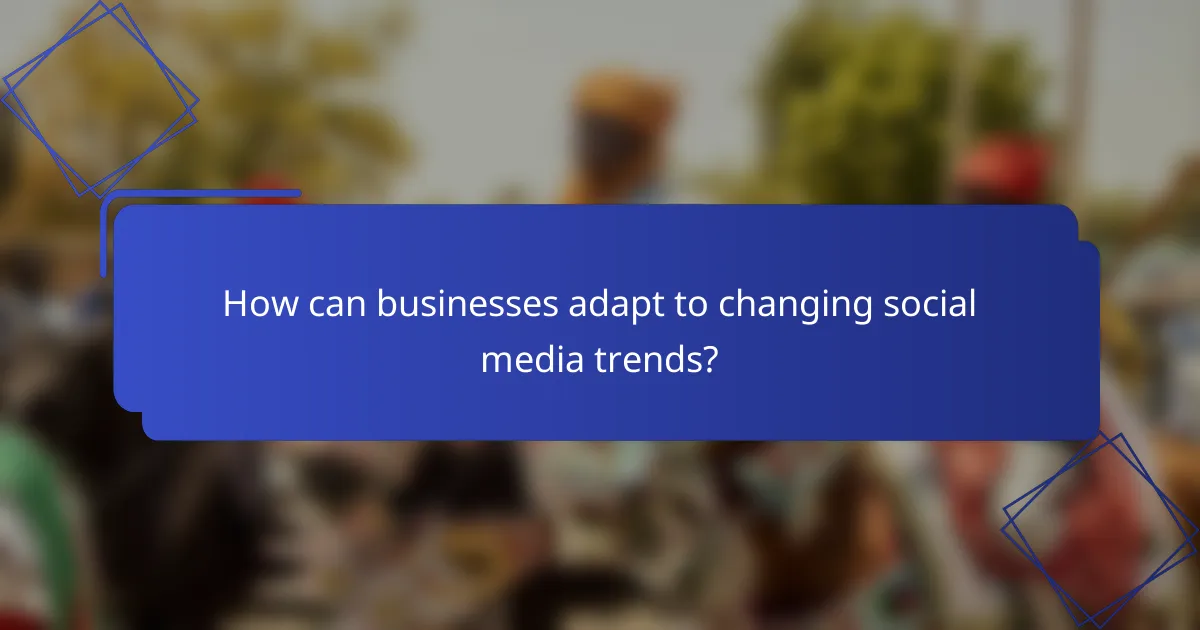Social media has become an essential tool for businesses looking to connect with their target audience and achieve their marketing goals. By understanding the unique advantages of platforms like Facebook, Instagram, and TikTok, companies can tailor their advertising strategies effectively. Additionally, engaging with local communities through targeted content and location-based advertising can significantly enhance brand visibility and customer interaction.

Which social media platforms are most effective for advertising?
The most effective social media platforms for advertising vary by target audience and campaign goals. Generally, Facebook, Instagram, LinkedIn, Twitter, and TikTok each offer unique advantages that can be leveraged for successful advertising strategies.
Facebook for targeted ads
Facebook is renowned for its robust targeting capabilities, allowing advertisers to reach specific demographics based on interests, behaviors, and location. Businesses can create highly customized ads that resonate with their audience, making it effective for both brand awareness and conversions.
Utilizing Facebook’s Ads Manager, advertisers can set budgets, schedule campaigns, and analyze performance metrics. A/B testing different ad formats and targeting options can help optimize results, ensuring that your advertising spend is used effectively.
Instagram for visual engagement
Instagram excels in visual storytelling, making it ideal for brands that rely on imagery to engage their audience. With features like Stories, Reels, and shoppable posts, businesses can create immersive experiences that capture attention and drive sales.
To maximize engagement, focus on high-quality visuals and authentic content that reflects your brand’s identity. Collaborating with influencers can also enhance reach, as they often have dedicated followings that trust their recommendations.
LinkedIn for B2B marketing
LinkedIn is the premier platform for B2B marketing, offering access to a professional audience. Advertisers can target users based on job title, industry, and company size, making it effective for lead generation and brand positioning in professional circles.
Sponsored content, InMail campaigns, and display ads are common formats on LinkedIn. Sharing valuable content, such as whitepapers or case studies, can establish authority and encourage engagement from potential clients.
Twitter for real-time interaction
Twitter is ideal for real-time engagement and customer interaction. Its fast-paced nature allows brands to respond quickly to trends, news, and customer inquiries, fostering a sense of immediacy and connection.
Using hashtags strategically can increase visibility and participation in conversations. Brands should focus on concise messaging and engaging visuals to capture attention in a crowded feed, while also monitoring analytics to refine their approach.
TikTok for younger demographics
TikTok is rapidly gaining popularity among younger audiences, making it a powerful platform for brands targeting Gen Z and millennials. The platform’s emphasis on short, entertaining videos allows for creative and engaging advertising opportunities.
Brands can leverage trends and challenges to create relatable content that resonates with users. Collaborating with TikTok influencers can amplify reach and authenticity, driving higher engagement rates and brand loyalty.

How can businesses develop effective social media strategies?
Businesses can develop effective social media strategies by clearly defining their target audience, setting measurable goals, creating engaging content, and utilizing analytics for continuous optimization. These steps help ensure that social media efforts align with business objectives and resonate with the intended audience.
Define target audience
Identifying the target audience is crucial for tailoring social media strategies. Businesses should consider demographics such as age, gender, location, and interests to create a profile of their ideal customer. Tools like surveys and social media insights can provide valuable data to refine this understanding.
Once the target audience is defined, businesses can segment them into groups based on shared characteristics. This allows for more personalized messaging and content that speaks directly to each segment’s needs and preferences.
Set measurable goals
Setting measurable goals helps businesses track the effectiveness of their social media strategies. Goals should be specific, achievable, and time-bound, such as increasing followers by a certain percentage or boosting engagement rates within a defined period. Using the SMART criteria can guide this process.
Regularly reviewing these goals ensures that businesses can adapt their strategies as needed. For example, if a goal is not being met, it may indicate a need to adjust content types or posting frequency.
Create engaging content
Engaging content is key to capturing the attention of the target audience. This includes a mix of formats such as images, videos, and stories that resonate with users. Content should be informative, entertaining, or inspiring to encourage shares and interactions.
Utilizing user-generated content can also enhance engagement. Encouraging customers to share their experiences with the brand can create a sense of community and authenticity, making the brand more relatable.
Utilize analytics for optimization
Analytics play a vital role in optimizing social media strategies. Businesses should regularly review metrics such as engagement rates, click-through rates, and conversion rates to assess performance. Tools like Google Analytics and platform-specific insights can provide detailed reports on audience behavior.
Based on analytics, businesses can make informed decisions about content adjustments, posting times, and audience targeting. For instance, if analytics show that posts perform better on certain days or times, businesses can schedule their content accordingly to maximize reach and engagement.

What are the best practices for local social media marketing?
Effective local social media marketing involves engaging with your community, utilizing location-based advertising, and promoting local events. These strategies help businesses connect with their target audience and drive foot traffic or online engagement.
Engage with local communities
Building relationships with local communities is crucial for successful social media marketing. Engage with local groups, respond to comments, and participate in conversations relevant to your area. This fosters trust and encourages word-of-mouth referrals.
Consider hosting local contests or giveaways that require participants to share your content or tag friends. This not only increases visibility but also strengthens community ties.
Leverage location-based advertising
Location-based advertising allows businesses to target specific geographic areas, making it an effective tool for local marketing. Platforms like Facebook and Instagram offer options to reach users based on their location, ensuring your ads are seen by potential customers nearby.
Utilize geotargeting to promote special offers or events that are exclusive to local audiences. This can significantly increase engagement and conversion rates, as users are more likely to respond to promotions that are relevant to their immediate surroundings.
Highlight local events and promotions
Promoting local events and special offers can attract attention and drive traffic to your business. Share information about community events, festivals, or markets on your social media channels to position your brand as an active participant in the local scene.
Consider creating a content calendar that aligns your promotions with local events. This ensures timely and relevant messaging, maximizing your reach and engagement with the community.

What metrics should be tracked for social media success?
To measure social media success, focus on key metrics such as engagement rates, conversion rates, follower growth, and reach and impressions. These metrics provide insights into how well your content resonates with your audience and the effectiveness of your overall strategy.
Engagement rates
Engagement rates reflect how actively users interact with your content, including likes, shares, comments, and saves. A higher engagement rate indicates that your audience finds your content valuable and relevant. Aim for engagement rates of around 1-5% as a general benchmark, but this can vary by platform and industry.
To improve engagement, create content that encourages interaction, such as polls, questions, or contests. Monitor which types of posts generate the most engagement to refine your strategy over time.
Conversion rates
Conversion rates measure the percentage of users who take a desired action after engaging with your content, such as making a purchase or signing up for a newsletter. A good conversion rate typically ranges from 1-3%, but this can vary based on your industry and the specific goals of your campaign.
To enhance conversion rates, ensure your calls to action (CTAs) are clear and compelling. Test different CTAs and landing pages to determine what resonates best with your audience.
Follower growth
Follower growth indicates how quickly your audience is expanding on social media platforms. Tracking this metric helps you understand the effectiveness of your content and promotional strategies. A steady growth rate of around 2-5% per month is often considered healthy.
To boost follower growth, consistently post high-quality content, engage with your audience, and collaborate with influencers or brands that align with your values. Running targeted ads can also help attract new followers.
Reach and impressions
Reach refers to the total number of unique users who see your content, while impressions count how many times your content is displayed, regardless of whether it was clicked. High reach and impressions indicate strong visibility, which is crucial for brand awareness. Aim for a reach that exceeds your follower count to ensure your content is being shared beyond your immediate audience.
To maximize reach and impressions, use relevant hashtags, post at optimal times, and engage with trending topics. Analyze your performance data to identify which posts achieve the highest reach and adjust your strategy accordingly.

How can businesses adapt to changing social media trends?
Businesses can adapt to changing social media trends by actively monitoring new platforms and staying informed about algorithm updates. This proactive approach helps them engage effectively with their target audience and optimize their content strategy.
Monitor emerging platforms
Keeping an eye on emerging social media platforms is essential for businesses looking to reach new audiences. Platforms like TikTok and Clubhouse have gained traction quickly, often appealing to younger demographics. Companies should evaluate these platforms to determine if they align with their brand and target market.
To effectively monitor new platforms, businesses can set up alerts for industry news and follow social media influencers who specialize in digital trends. Engaging with early adopters can provide insights into how these platforms function and what content resonates with users.
Stay updated on algorithm changes
Social media algorithms frequently change, affecting how content is displayed to users. Understanding these changes is crucial for businesses to maintain visibility and engagement. For example, platforms like Facebook and Instagram often prioritize content from users’ friends and family over brands, which can impact organic reach.
To stay informed about algorithm updates, businesses should regularly check official blog posts from social media platforms and follow industry experts. Adapting content strategies based on these changes—such as increasing video content or utilizing stories—can help businesses remain competitive.



